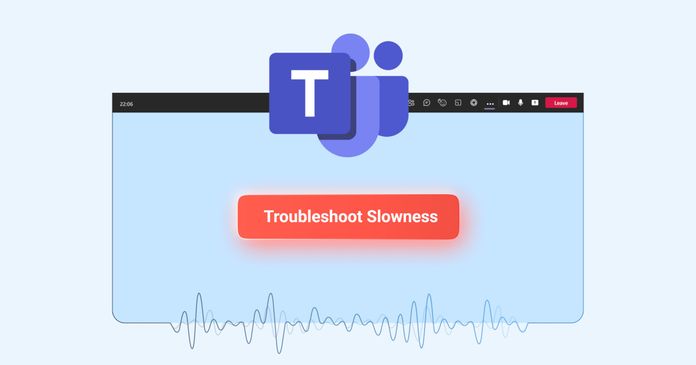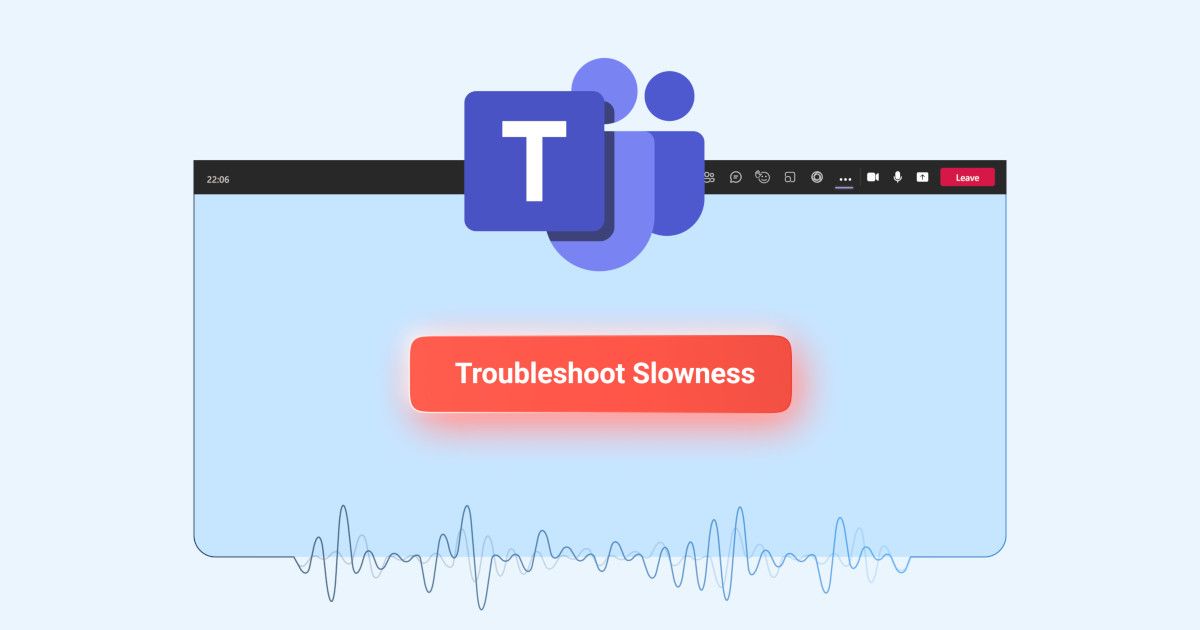Table of Contents
Table of Contents
How many times has this happened? You're on a Microsoft Teams call, and your call disconnects, lags or freezes. so you go to Google to look up how to solve the problem. Well look no further!
If you're using Microsoft Teams, there are proven ways to troubleshoot those pesky performance and connection issues that are putting a damper on your team's collaboration. We're teaching you the how-to's of Microsoft Teams troubleshooting to solve common Microsoft Teams performance and connection issues using Network Monitoring and Microsoft Teams Monitoring!
Here's the reality: When someone complains about poor Teams call quality, is it really a Teams issue? A network problem? Or maybe their workstation is struggling with resources? The frustration comes from not knowing where to look and wasting hours troubleshooting in the wrong direction.
That's where modern Microsoft Teams monitoring changes everything. Instead of playing the guessing game, you need visibility into three critical perspectives: the user's environment, your network performance, and Microsoft Teams itself. Because here's what most IT teams don't realize:
75% of Teams issues are network-related: Problems like jitter, packet loss, and congestion that severely impact audio and video quality
24% stem from the user side: Resource limitations, outdated hardware, or audio/visual equipment issues
Less than 1% are actually Microsoft's fault: Though everyone loves to blame the platform first

The good news? With the right monitoring approach, you can pinpoint the exact source of any Teams issue in minutes instead of hours. Whether it's happening in your business network, a remote employee's home office, or your ISP's network, you'll have all the information you need to troubleshoot Microsoft Teams issues - even remotely.
So grab your thinking cap and get ready to become a Teams troubleshooting pro! We're going to show you how to use Network Monitoring and Microsoft Teams Monitoring to identify, diagnose, and resolve Teams issues faster than ever before.
Microsoft Teams connection issues and performance issues can be greatly affected by poor network performance. Network problems like jitter, packet loss and congestion severely affect Teams’ audio and video performance - which is why Network Monitoring is your best tool for monitoring and troubleshooting Microsoft Teams issues.
Network performance is critical to the overall performance of Microsoft Teams. Teams is a cloud-based collaboration platform that relies heavily on a stable and fast Internet connection for smooth operation.
If the network performance is poor or unstable, it can cause a range of issues, including:
Microsoft Teams connection issues refer to difficulties in establishing and maintaining a stable network connection between the user's device and Microsoft's servers, affecting the real-time communication and collaboration features of the application. These issues can manifest as poor audio and video quality during meetings, delayed message delivery, or intermittent disconnection
There are several Microsoft Teams connection issues that users may encounter, including:
- Audio and video glitches: This is a common issue where the audio or video feed in Teams meetings may lag or freeze, causing communication issues and making it difficult for team members to interact.
- Slow or intermittent Internet connection: Slow or unreliable internet connection can also cause issues with Microsoft Teams, especially when it comes to video and audio quality.
- Connectivity problems: Teams can also experience connectivity problems, preventing users from being able to access the platform entirely.
- Firewall or network restrictions: Some companies may have strict firewall or network restrictions in place, which can cause connection issues when trying to use Teams.
- Outdated software or hardware: Using outdated software or hardware can also lead to performance and connection issues in Teams.


Microsoft Teams, like any software application, can experience performance issues that impact its functionality and user experience. Microsoft Teams performance issues differ from connection issues because encompass a broader range of challenges impacting Teams' overall functionality beyond mere connectivity problems.
While connection issues primarily relate to network reliability and speed, Teams performance issues encompass factors such as server overload, software bugs, device resource constraints, outdated software versions, integration problems, and more. These issues collectively contribute to a degraded user experience, resulting in slow response times, crashes, freezes, and overall sluggishness, thereby affecting the application's ability to operate smoothly and meet user expectations beyond just connectivity concerns.
There are a variety of Microsoft Teams performance issues that can pop up at any time, including:
- Slow loading times: Teams may take a long time to load, which can be frustrating and time-consuming.
- High resource usage: Teams can use a lot of system resources, such as CPU and RAM, which can slow down the user's device and cause performance issues.
- Video and audio quality issues: Poor quality audio and video during calls or meetings can be a performance issue that can affect the overall user experience.
- Application freezing or crashing: Teams may freeze or crash unexpectedly, causing users to lose progress and interrupting collaboration.
- Syncing issues: Teams may have difficulty syncing with other apps and services, causing delays and communication issues.
- Inconsistent performance: Teams may work fine for some users but perform poorly for others, making it challenging to identify the root cause of the issue.
- Outages: Microsoft Teams outages lead to complete loss of connectivity and can be caused my poor internal or external network performance.
It is important to troubleshoot these performance issues to ensure that Microsoft Teams operates smoothly and efficiently.
The whole "Work from Anywhere" shift is putting a serious squeeze on IT support desks, causing ripples through departments in companies worldwide. Microsoft Teams is on the rise is companies all over the world, but there's a catch. Companies are grappling with support challenges, thanks to old-school hardware problems and blind spots in keeping tabs on how remote workers' networks are performing.
Many employees won't bother ringing up the helpdesk when they hit a tech snag. So, it's up to the IT pros to spot who's having Microsoft Teams issues and troubleshoot as soon as possible.
Panagenda on the root-cause for Microsoft Teams performance issues, one of the top responses was network problems, proving that networks bottlenecks are a clear sore spot for IT teams.

The critical importance of Microsoft Teams troubleshooting lies in its direct impact on the seamless functioning of an organization's collaborative environment. Microsoft Teams has become a linchpin for communication, collaboration, and project management, and any disruptions in its performance can have cascading effects on productivity and business operations.
Identifying Performance Issues: Troubleshooting is crucial for identifying and addressing issues related to connectivity, performance, and overall functionality. Moreover, proactive troubleshooting enables IT teams to identify potential challenges before they escalate, allowing for strategic planning and optimization of the Teams environment. T
Improved User Experience: It ensures that employees can engage in effective real-time communication, join virtual meetings without interruptions, and share resources seamlessly. Beyond minimizing downtime, troubleshooting contributes to enhanced user satisfaction, as employees can rely on a reliable platform for their day-to-day tasks.
If you're a user wanting to troubleshoot Microsoft Teams issues, there are some basic troubleshooting steps you can follow to resolve common issues. These steps include:
- Checking your Internet connection: Ensure that you have a stable and fast Internet connection. You can use an online speed test tool or Obkio's Speed Test Tool to check your Internet speed and latency. If your internet connection is slow or unstable, it can cause performance issues in Teams.
- Restarting Teams: Closing and restarting Teams can help to resolve any temporary issues. This is a simple step that often resolves common issues, so it's worth trying before moving on to more advanced network troubleshooting steps.
- Checking for updates: Ensure that Teams is up to date with the latest version. You can check for updates within Teams under the "About" section in the Settings menu. Updates often include bug fixes and performance improvements that can help to resolve issues.
- Clearing the Teams cache: Clearing the Teams cache can resolve performance issues. You can do this by going to the Teams settings and selecting "Clear Cache." The cache stores temporary data and settings that Teams uses, and clearing it can help to resolve issues caused by corrupted or outdated data.
- Adjusting video and audio settings: Lowering the video resolution or disabling the camera or microphone can help to improve performance during Teams calls and meetings. This is especially important if you're experiencing issues with video or audio quality.
- Disabling hardware acceleration: Disabling hardware acceleration can help to reduce the load on your system's graphics card and improve Teams performance. You can disable this under the "General" section in the Teams settings. This step is especially useful if you're experiencing issues with Teams freezing or crashing.
By following these basic troubleshooting steps, you can resolve common issues and ensure a smooth collaboration experience in Microsoft Teams. If you continue to experience issues after trying these steps, you may need to reach out to your network administrator or IT specialist for more advanced troubleshooting steps.
However, if you're a network administrator or IT specialist, you may need to dig deeper into the issue and identify the root cause. So you're in the right place!
In this article, we'll cover more advanced troubleshooting steps that you can take to identify and resolve performance and connection issues in Microsoft Teams. These steps include monitoring network metrics and Microsoft Teams metrics, optimizing network performance, analyzing traceroutes, and more.
By following these steps, you can identify and resolve complex issues and ensure a reliable and efficient collaboration experience for your users. So, keep reading this article to learn more about troubleshooting Microsoft Teams performance and connection issues as a network administrator or IT specialist.
To first identify Microsoft Teams performance issues, you need to continuously monitor your network and Microsoft Teams connection quality, performance, and call quality from every angle. To do so, we recommend Obkio's Network and Microsoft Teams Monitoring Tool.

Obkio's Microsoft Teams Monitoring tool is the ultimate weapon for troubleshooting Microsoft Teams performance and connection issues. It goes beyond basic network monitoring by providing visibility into three critical perspectives:
- The user environment
- TTThe network**
- Microsoft Teams itself
This helps you quickly determine whether issues stem from user workstations (24% of cases), network problems (75% of cases), or Microsoft's platform (less than 1% of cases).
Obkio's Monitoring Agents actually join Microsoft Teams meetings and exchange audio and video data using synthetic testing. This means you don't need an active Teams call to monitor performance, you'll always have visibility into potential issues, even before they happen.
With end-to-end monitoring that covers up to 99% of the call path during Teams calls, you can pinpoint problems faster and troubleshoot with confidence.


To begin monitoring Microsoft Teams network performance with Obkio, you need to deploy Monitoring Agents which continuously measure network and Teams performance in all network locations where Teams is being used.
In our previous article in our Microsoft Teams series, How to Monitor Microsoft Teams Issues, we talk about setting up the Monitoring Agents, so you can refer to that article for deployment.
But essentially, to collect the data you need to translate, you’ll need:
1 Azure Agent: Microsoft Teams stores customer data in Microsoft Azure’s global cloud locations. To monitor Microsoft Teams, deploy a Microsoft Azure Agent deployed in the Data Center located closest to you.
1 other Public Monitoring Agent: To compare performance up to the Internet and quickly identify if the problem is global or specific to Teams. This will be great information for later in the troubleshooting process. You can use an AWS Agent or Google Cloud Agent.
1 Local Agent: Installed in the targeted office location experiencing the Microsoft Teams performance issues. There are several Agent types available (all with the same features), and they can be installed on MacOS, Windows, Linux and more.
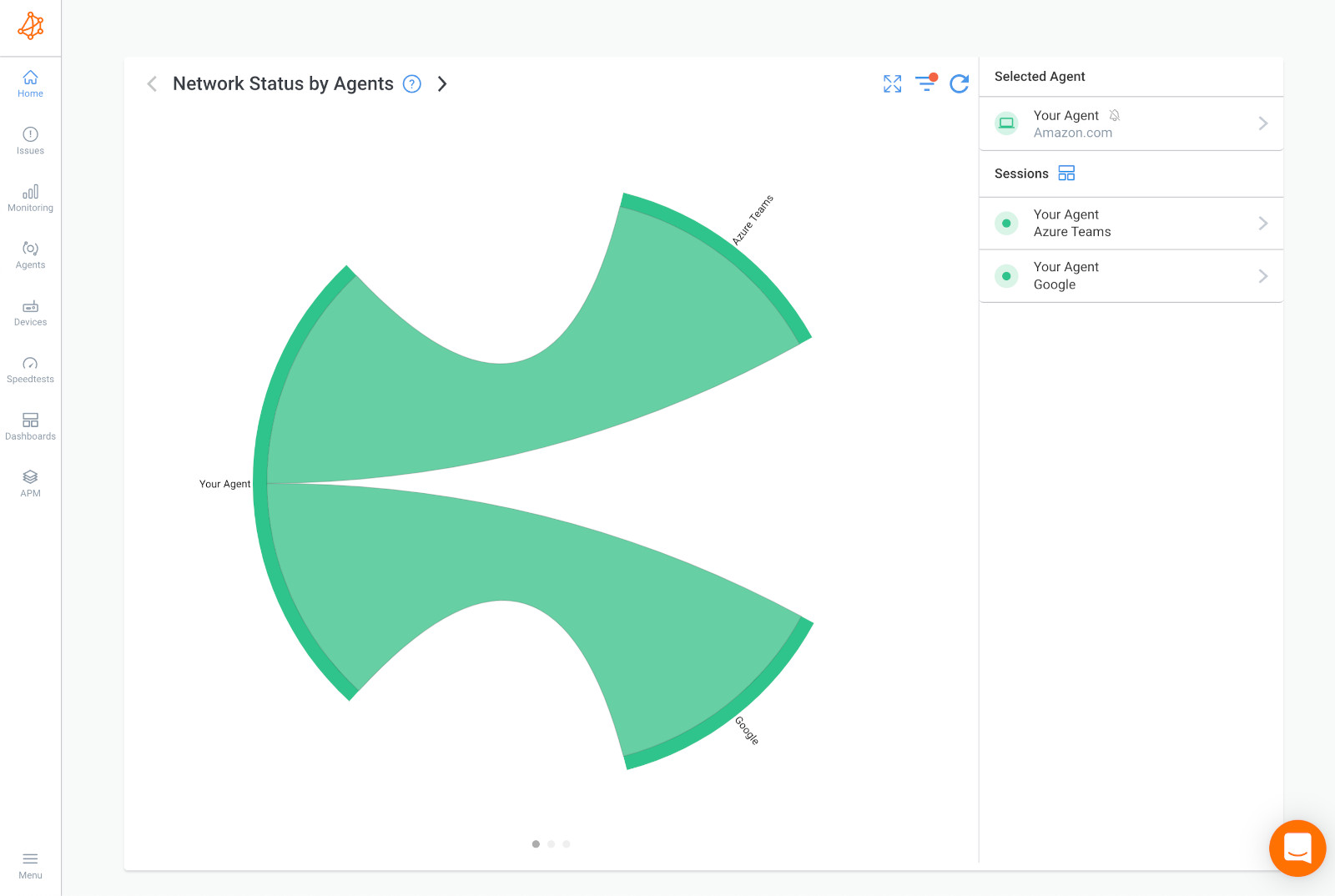
This same setup can also be used for:
- Microsoft network monitoring
- Microsoft Dynamics 365 performance monitoring
- Microsoft Azure network monitoring
Once your Monitoring Agents are deployed, they’ll start continuously exchanging synthetic UDP traffic between each other to monitor Microsoft Teams performance, this is called a Network Monitoring Session.
To identify ant Microsoft Teams issues, you’ll want to let the Agents run and collect data. If you’re unlucky enough, you’ll see the performance issues after just a few minutes, but we recommend letting the Agents collect data for at least 3 hours.
When troubleshooting Microsoft Teams issues, the biggest challenge isn't finding a problem—it's finding the right problem. Is it the user's workstation struggling with resources? Is it network congestion? Or is it actually Microsoft's platform? That's where Obkio's three-perspective monitoring approach becomes your troubleshooting superpower.
Monitoring from Three Critical Angles
1. The User Perspective
Obkio monitors key metrics from the user's environment, including network card performance, CPU usage, and disk usage. This helps you identify if the user's workstation has enough resources to run Microsoft Teams smoothly. With 24% of Teams issues originating from the user side, often due to audio/visual equipment or workstation resource limitations—this visibility is crucial for quick resolution.
2. The Network Perspective
Here's where Obkio really shines. Since 75% of Teams issues are network-related, our enterprise-grade Network Performance Monitoring continuously tracks when, where, and how network issues arise. We monitor all network metrics in real-time, including latency, jitter, packet loss, and bandwidth. Obkio even helps you identify if internal network congestion from improper Quality of Service (QoS) configuration is causing problems—which accounts for 50% of internal network issues.
3. The Microsoft Teams Perspective
Obkio connects directly to Microsoft's API to download detailed call quality reports, including audio quality, video quality, latency, jitter, and Average Call Quality Score. This data, combined with our synthetic testing, helps you determine if the problem is actually on Microsoft's end (though this is rare—less than 1% of cases).

Obkio's Monitoring Agents don't just passively collect data—they actively participate in Microsoft Teams meetings to test performance:
- The Obkio platform creates a Microsoft Teams meeting
- Obkio Agents (with Obkio-provided Office 365 licenses) join the meeting
- For 35 seconds, Agents inject audio and video traffic, simulating real communication
- The Agents leave the meeting
- Obkio requests performance metrics from Microsoft's API
- This cycle repeats every minute for continuous monitoring
The best part? You don't need to be a Microsoft Teams admin or have special access permissions. Obkio handles all the licensing automatically and mirrors the exact call path between the agent and Teams tenant based on user location.
What This Means for Microsoft Teams Troubleshooting
With data from all three perspectives displayed side-by-side in Obkio's intuitive dashboard, you can instantly correlate metrics and pinpoint exactly where problems are occurring. No more guessing whether it's a network issue, user problem, or platform outage—you'll have the concrete data you need to troubleshoot efficiently and resolve issues faster.
When the Agents start exchanging traffic, they start monitoring and collecting performance data, which you can see on the Network Response Time Graph. If you’re experiencing Microsoft Teams performance or connection issues, you’ll be able to see them in the graph. You can see the data for network metrics like:
- Latency: Latency is the time it takes for data to travel from the user's device to the Teams server and back. High Microsoft Teams latency can cause delays in audio (VoIP latency) and video during calls and meetings, leading to a poor user experience.
- Packet Loss: Packet loss is the percentage of data packets that are lost during transmission over the network. High packet loss can cause audio and video quality issues during Teams calls and meetings.
- Jitter: Jitter is the variation in delay between data packets. High jitter can cause audio and video to be out of sync during Teams calls and meetings.
- Bandwidth: Bandwidth is the maximum amount of data that can be transmitted over a network in a given amount of time. Low bandwidth can cause audio and video to be of poor quality or not work at all.
- Network Congestion: Network congestion occurs when there is a high volume of data traffic on the network. This can cause delays, packet loss, and poor audio and video quality during Teams calls and meetings.
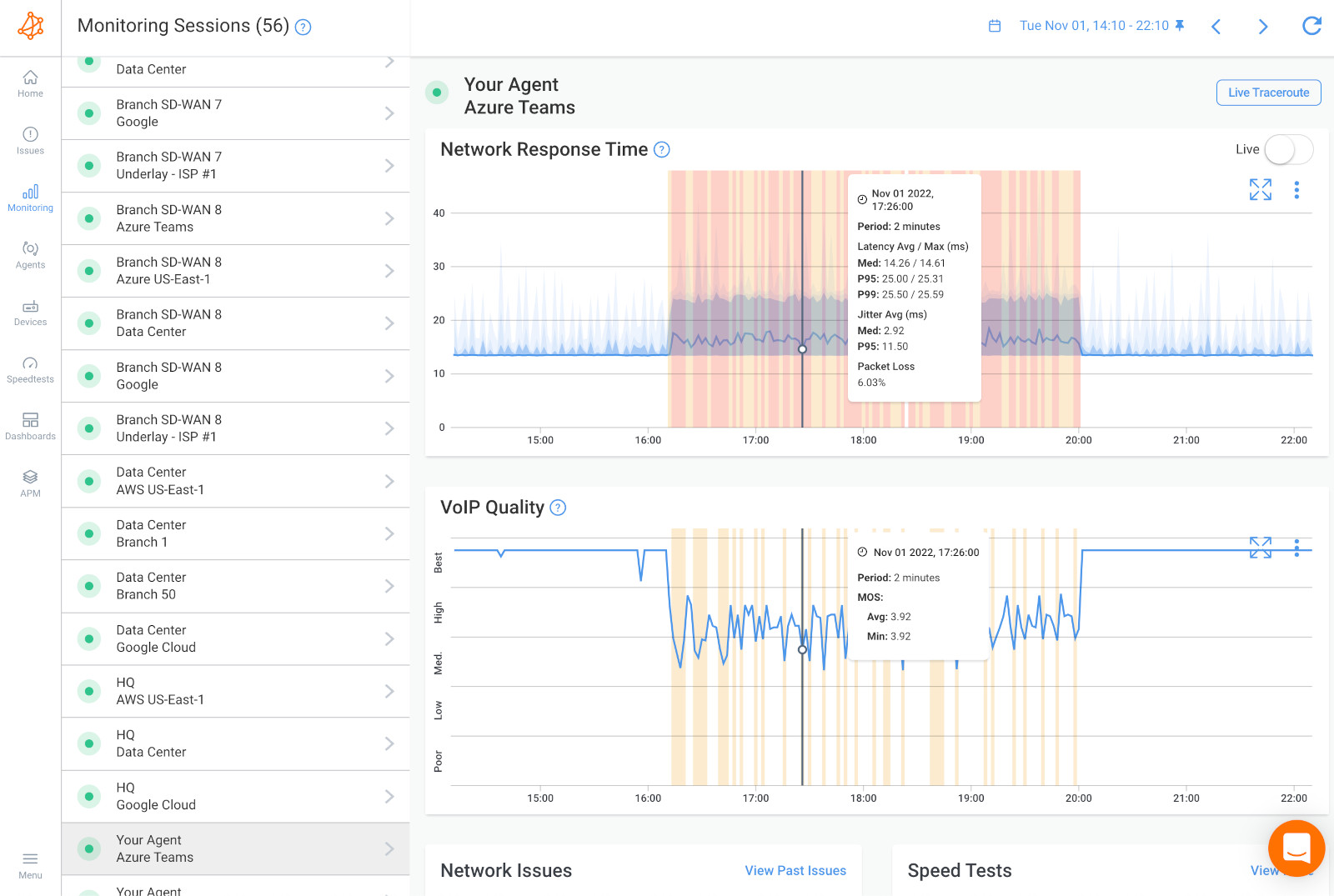 Obkio's Network Response Time Graph and VoIP Quality Graph showing Latency, Jitter, and Packet Loss
Obkio's Network Response Time Graph and VoIP Quality Graph showing Latency, Jitter, and Packet Loss
A Microsoft Teams network assessment will help guide you through this process also. We talk more about this in our article on the subject.
Beyond network metrics, Obkio's Teams monitoring also tracks Microsoft Teams-specific performance indicators:
- VoIP Quality & MOS Score: Mean Opinion Score measures overall call quality, with scores above 4.0 indicating excellent quality
- Audio Quality, Latency, and Jitter: Specific metrics for audio stream performance during Teams calls
- Video Quality, Latency, and Jitter: Dedicated metrics for video stream performance and stability
- Average Call Quality Score: Microsoft's own assessment of overall meeting quality from their API data

From here, we’ll start with the 3 Microsoft Teams troubleshooting steps.
To begin troubleshooting your Microsoft Teams connection or performance issue, you need to first know: Is it a network problem? Some performance and connection issues may not be caused by network performance at all, so it's important to know where to direct your troubleshooting efforts.
Instead of just comparing network sessions, you now have three distinct data sources displayed side-by-side in your dashboard: user environment metrics, network performance data, and Microsoft Teams-specific call quality metrics.
Here's how to use this three-perspective view to quickly isolate the problem:
If you see issues in Microsoft Teams metrics but NOT in network metrics: The problem is likely on Microsoft's platform side (rare, but it happens). Check Microsoft's status page for any ongoing outages.
If you see issues in network metrics AND Teams metrics: You've confirmed it's a network problem. Continue with the comparison steps below to determine if it's internal or external to your network.
If you see issues in user environment metrics (high CPU, memory constraints): The problem is on the user's workstation. Work with your IT team to address resource limitations or hardware issues.
This multi-perspective approach means you can often identify the root cause in minutes rather than hours. Now let's dive into the network-specific troubleshooting steps:
In the screenshot below, you’ll see an example of a Network Session with no Microsoft Teams performance or connections issues. As a reference, this is what it looks like when the network isn’t the cause of your performance problem.
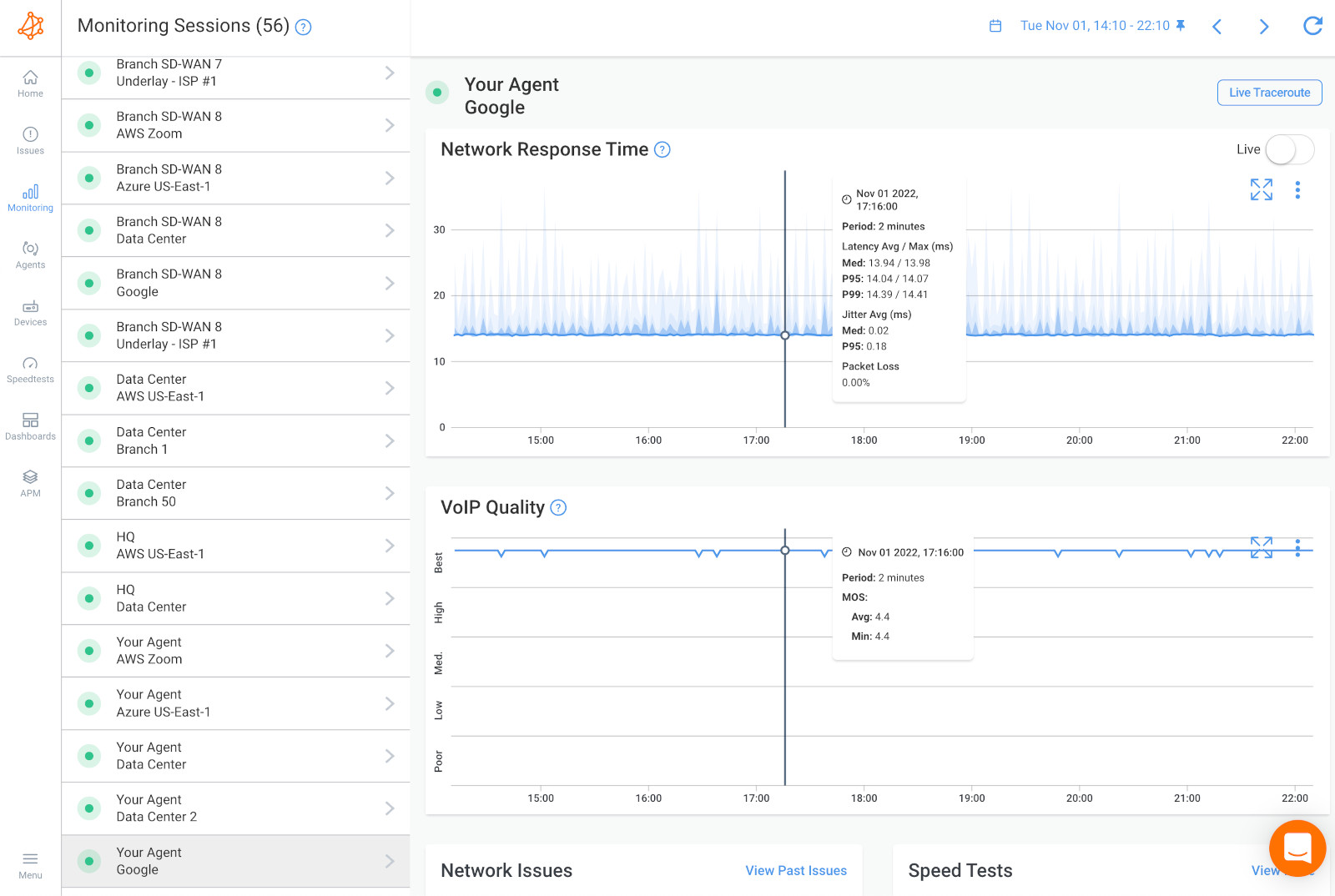
If it’s not a network issue, it might be a user issue. In this case, you can install a Monitoring Agent directly on the workstation of the user experiencing the Microsoft Teams issues to get a performance perspective from their point-of-view.
If you still don’t find a network problem at this point, it may just be a problem that can be solved directly on the user's workstation. Microsoft Teams, like several other hardware-intensive unified communication systems, uses lots of resources (CPU, RAM).
Obkio also monitors these important resource metrics so you can understand if your Microsoft Teams is lacking resources.
In the screenshot below is an example of a network problem on both network sessions.
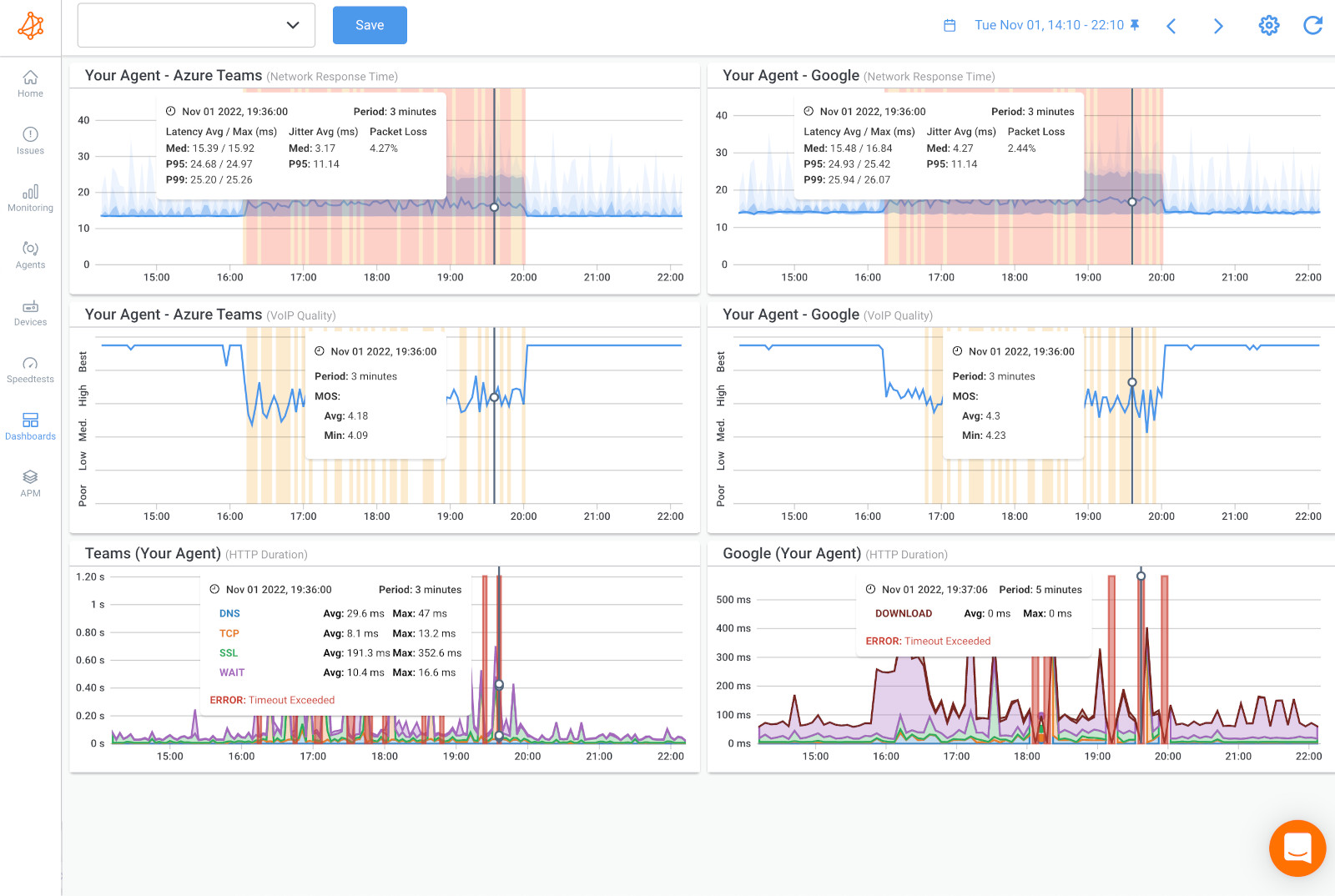
This means that the Microsoft Teams performance or connection issue is on a network segment that is common to both network sessions. Therefore the problem is broader, not exclusive to just Microsoft Teams, and affects all services and applications that depend on the network.
This could be in the LAN, the firewall or the local loop Internet connection.
In the screenshot below is an example of a Microsoft Teams issue happening on only one network session.
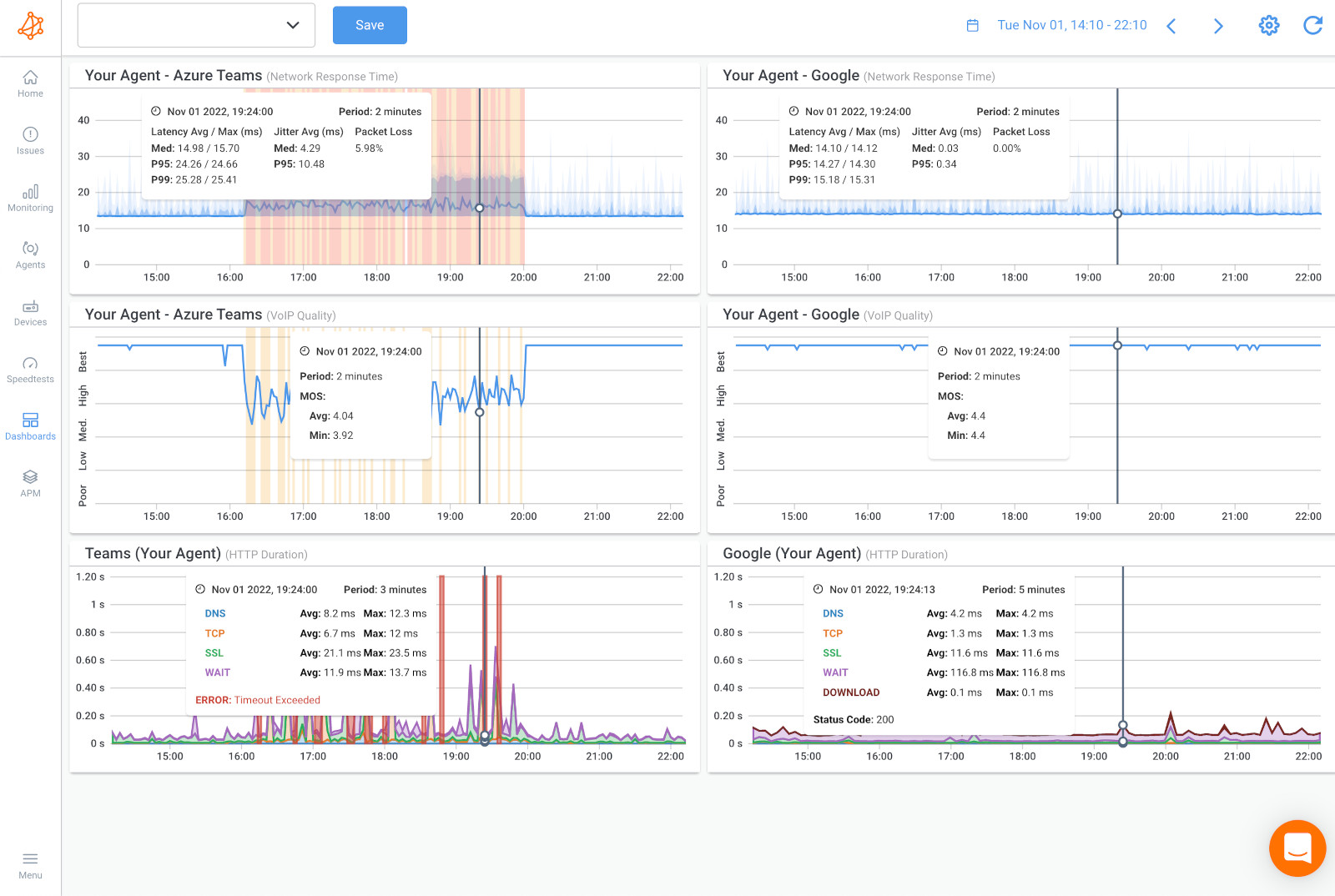
This means that the network problem is happening specifically towards that specific location on the Internet and that the problem is further away.
If the Microsoft Teams issue is happening on both network sessions, compare that data using Obkio’s Device Monitoring feature to further understand if the performance issue is happening on your end, or over the Internet, in your Service Provider’s network.
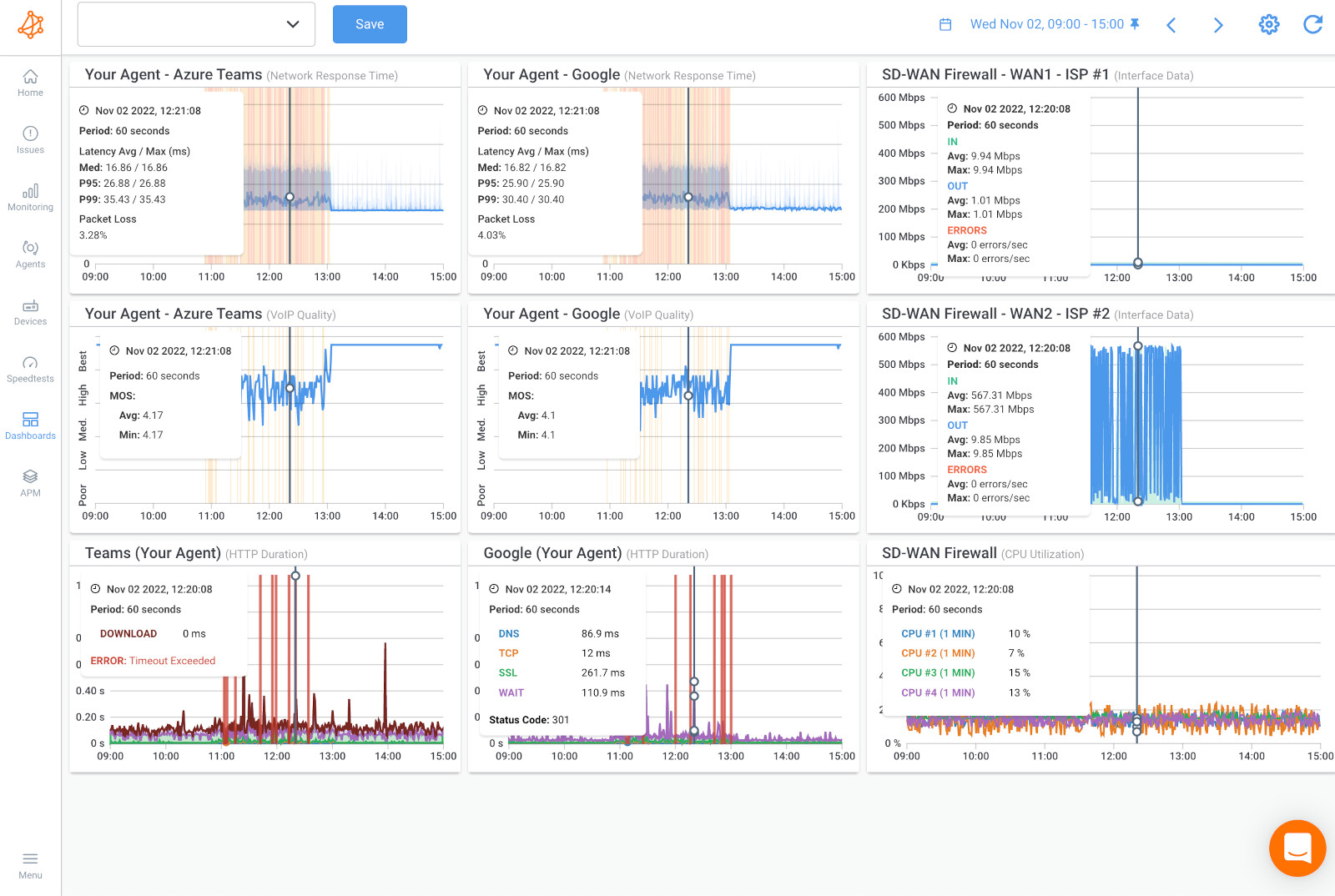
When you compare your previous performance data with the Device Monitoring metrics, if you find CPU or Bandwidth issues, this likely means that the Microsoft Teams problem is on your end - so you need to address it.
High CPU Usage could indicate that your device is struggling to handle the demands of running Microsoft Teams, potentially causing slowdowns or even crashes.
Bandwidth Issues might suggest that your network is strained, affecting the smooth flow of data required for Teams' audio and video functions. Identifying these issues in your own infrastructure is the first step towards resolution.
Identifying these issues in your own infrastructure is the first step towards resolution. Whether it's optimizing device performance, upgrading hardware, or fine-tuning your network configurations, addressing these internal factors is crucial to ensuring a seamless and reliable Microsoft Teams experience for your team.
Here’s what you can do:
- Look into the firewall logs to understand if the traffic going through your network is legitimate or not. Illegitimate traffic might be due to a security breach (data exfiltration), or mass data backup happening during business hours.
- Manage priorities in your Firewall to prioritize Microsoft Teams traffic and reduce the impact on Microsoft Teams during periods of congestion. This way, all the traffic towards or from Microsoft Teams will be prioritized first when passing through the network.
- Upgrade your Internet connection bandwidth with your ISP if you’re running out of bandwidth.
- Look into your device to understand why it’s missing resources and causing high CPU usage. There may be a software problem, your device may need a firmware update, the last update may be bugged, or the device may just not have enough resources available and needs to be upgraded to a bigger device.
By leveraging Device Monitoring metrics, you not only pinpoint the source of the problem but also empower yourself to take targeted actions that enhance overall performance.
If you don’t see any resource issues from your network devices, this is a sign that the Microsoft Teams performance issue is happening on your Service Provider’s side. In such cases, the responsibility shifts beyond your local infrastructure, indicating that the bottleneck or disruption may lie within the network provided by your ISP.
Issues like network congestion, packet loss, or latency on the service provider's side can impact the smooth operation of Teams. It becomes crucial to engage with your ISP to investigate and resolve these external factors affecting your connectivity. In this case, open a service ticket with your ISP with all the information you can collect so your request can be quickly escalated past 1st level support.
Obkio is going to get you all that information you need. The data you can provide is that from your dashboard in the previous steps, as well as your Traceroutes in the next step. Proactive communication with your service provider, coupled with the insights gained from Device Monitoring, allows you to pinpoint the source of the problem accurately, facilitating a collaborative approach to troubleshooting and ensuring a more robust and reliable Microsoft Teams experience for your team.
Step 5. Microsoft Teams Troubleshooting with Traceroutes: Microsoft Teams Connection Issues & Performance Issues in the ISP Network
You can now collect information about where exactly the network problem is located so you can share that information with your Service Provider.
To do this, we’ll be using Obkio Vision, Obkio’s free Visual Traceroute tool that runs continuously to interpret Traceroute results to identify network problems in your WAN and over the Internet.
Note: If the network problem is happening on your end, you don’t need to do this step. It’ll just further confirm that conclusion.
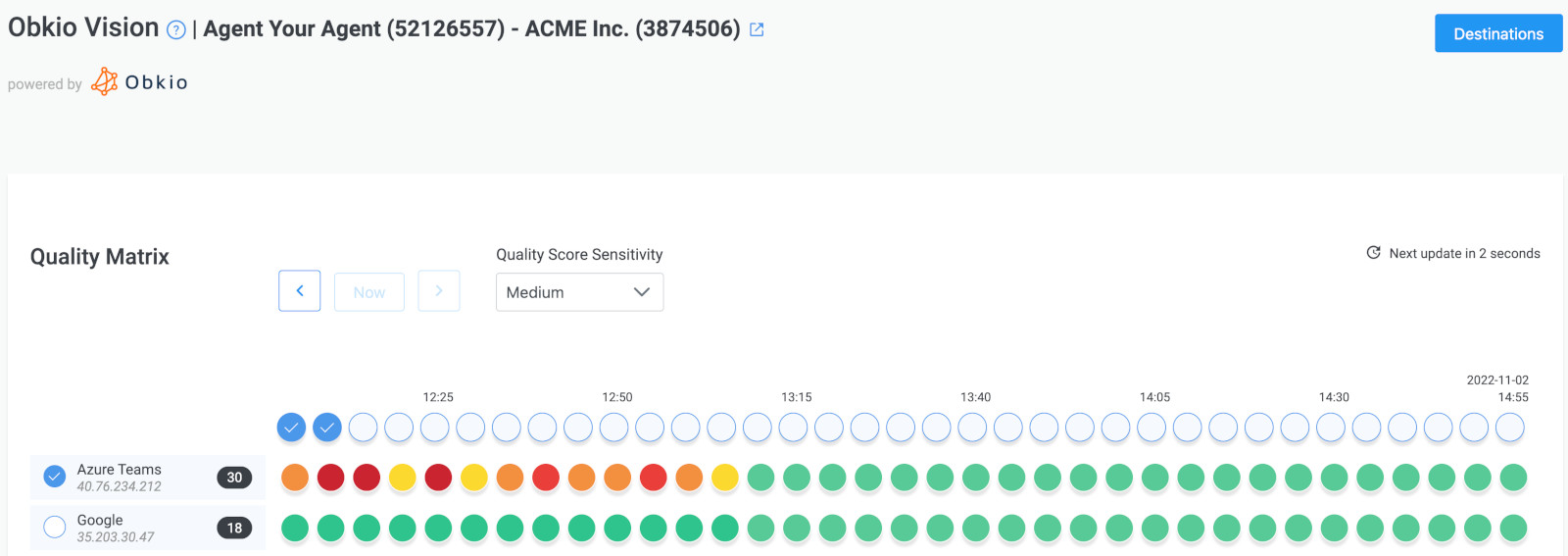 Obkio Vision Quality Matrix
Obkio Vision Quality Matrix
By using Traceroutes, the Network Map, and the Quality Matrix you’ll be able to identify if:
A. The problem is happening specifically towards a specific location over the Internet. So only one specific site is being affected.

B.The performance issue is on your ISP’s side and you need to open a service ticket providing as much information as you can collect.
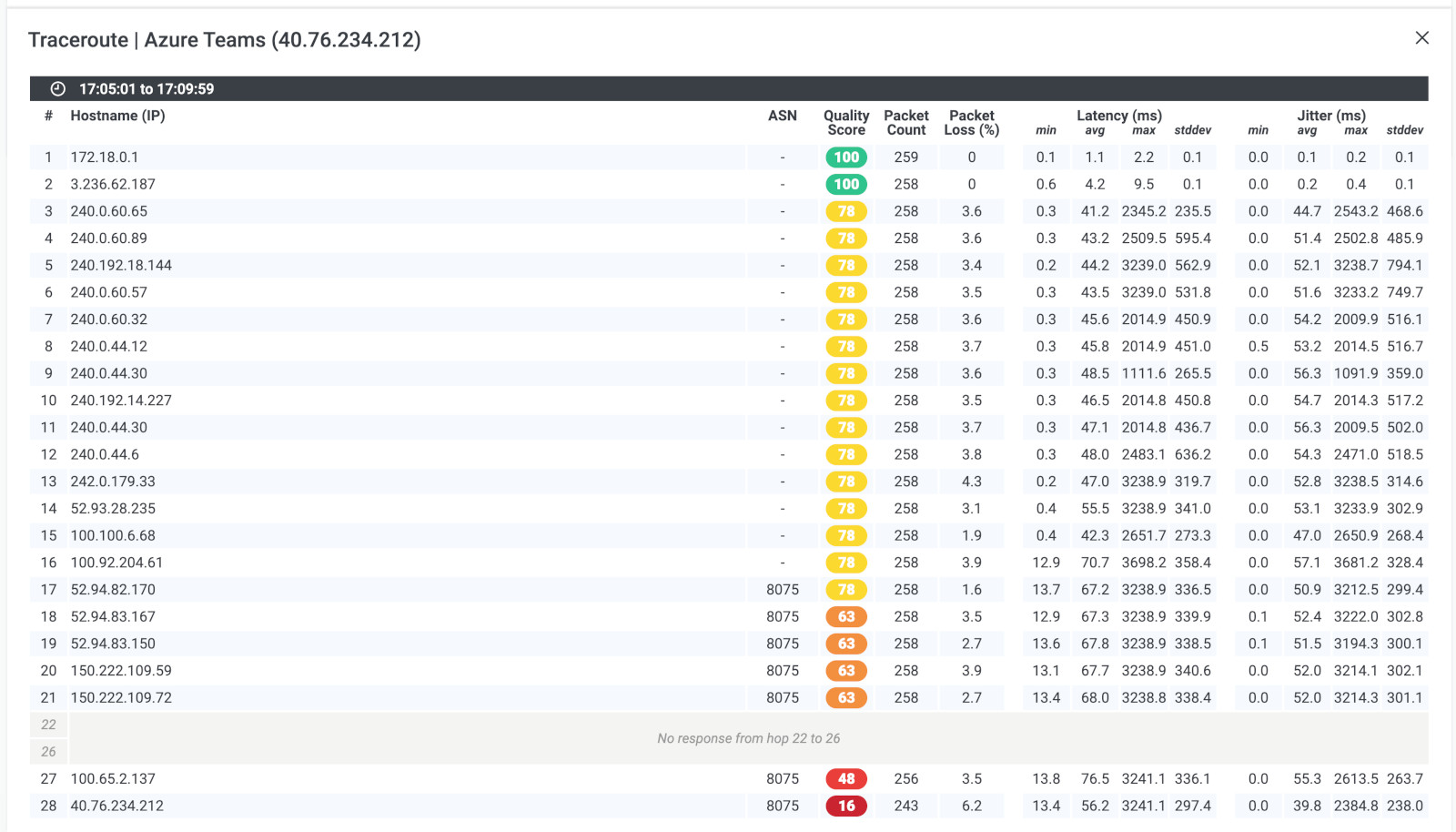
- Contact your ISP to get technical support using the screenshots of Monitoring Sessions, Dashboards or Traceroutes in Vision.
- Share results of Live Traceroutes with your ISP using a public link.
- If your ISP wants to analyze your data further, you can create a temporary Read-Only User in your Obkio account for them.
Learn how to use Obkio Vision’s Visual Traceroute tool to troubleshoot network problems with traceroutes in your LAN, WAN, and everything in between.
Learn more

Navigating Microsoft Teams smoothly relies on a stable and reliable performance and connection environment. However, various factors can contribute to issues. In the previous steps, we explained how to isolate Microsoft Teams issues to understand the cause, and troubleshoot based at the root. There are a variety of different causes for Teams performance and connection issues, so let's expand on them.

Problems related to network performance, including bandwidth limitations, congestion, jitter, packet loss, and latency, which can affect the real-time communication and collaboration features of Teams.
- Bandwidth Limitations: Insufficient bandwidth can lead to laggy audio and video, delays in message delivery, and overall sluggish performance.
- Network Congestion: High levels of traffic on the network can result in slow response times and degraded performance during peak usage hours. This can include WAN and LAN congestion.
- Jitter: Jitter leads to bariability in packet arrival times that can disrupt audio and video quality during Teams meetings.
- Packet Loss: Packet Loss during transmission can cause interruptions and impact the quality of audio and video calls.
- Latency: Poor latency, or delay in data transfer between devices can lead to delays in communication and collaboration.
This category addresses challenges arising from the devices themselves, such as insufficient resources (RAM, processor) and outdated hardware, impacting the ability of devices to run Microsoft Teams effectively.
- Insufficient Resources: Devices with low RAM or older processors may struggle to handle the demands of Microsoft Teams, leading to performance issues.
- Outdated Hardware: Using outdated or incompatible hardware can result in compatibility issues and degraded performance.
Encompasses problems within the Microsoft Teams application, including software bugs and glitches, as well as issues arising from using outdated software versions.
- Software Bugs: Bugs or glitches in the Microsoft Teams application can cause crashes, freezes, and unexpected behavior.
- Outdated Software: Using an outdated version of Microsoft Teams or related software components can lead to performance issues.
Focuses on problems related to the Internet Service Provider (ISP), such as network outages or instability, which can affect the connectivity and performance of Microsoft Teams.
- ISP Problems: Issues with the Internet Service Provider (ISP), such as network outages or instability, can impact Teams' connectivity and performance.
- Network Outages: Frequent or prolonged outages in the Internet Service Provider's network can disrupt Teams connectivity.
- Inconsistent Speeds: Fluctuating internet speeds from the ISP can lead to variations in Teams performance.
- DNS Resolution Issues: Problems with the Domain Name System (DNS) resolution can result in delays when accessing Teams services.
CPU and memory are critical resources for running applications smoothly. High CPU usage and memory constraints can impact Microsoft Teams' performance, causing delays and disruptions. Monitoring and optimizing these resources are essential for a seamless experience.
- High CPU Usage: Intensive CPU tasks, such as video rendering or background processes, can lead to performance issues within Microsoft Teams.
- Memory Constraints: Insufficient RAM may result in slow application response and overall system performance degradation.
Home office environments introduce unique challenges, including Wi-Fi interference, router configurations, and limited bandwidth. Addressing these factors is crucial to ensure stable Microsoft Teams connectivity and performance for remote workers.
- Wi-Fi Interference: Interference from other devices or neighboring networks in a home environment can impact Wi-Fi performance for Microsoft Teams.
- Router Configuration Issues: Improper router settings or outdated firmware may contribute to connectivity problems.
- Limited Bandwidth: Sharing a home network with multiple devices or high-bandwidth activities can result in reduced Teams performance.
Virtual Private Networks (VPNs) are commonly used for secure remote access, but misconfigurations or bottlenecks in VPNs can lead to routing problems affecting Microsoft Teams. Proper VPN setup and maintenance are essential for optimal performance.
- Incorrect VPN Configuration: Misconfigurations in VPN settings can lead to routing problems affecting the connection and performance of Microsoft Teams.
- VPN Bottlenecks: Overloaded VPN servers or slow VPN connections can hinder Teams' performance for remote users.
Discover why Microsoft Teams runs slow and learn effective strategies to identify and resolve Microsoft Teams slow performance issues for seamless calls.
Learn more

At this point, you'll have identified if the Microsoft Teams issues are being happening in your local network or your ISP network. You'll also know what caused them, when, and why. If the issues are happening in your ISP's network, it's up to them to troubleshoot.
If the problems are happening locally, here are some more tips to follow to troubleshoot Microsoft Teams connection issues:
- Check your Internet connection: Ensure that you have a stable and fast internet connection. You can use an online speed test tool to check your internet speed and latency.
- Restart Microsoft Teams: Close Teams and restart the application. This can help to resolve any temporary issues.
- Check for updates: Ensure that Teams is up to date with the latest version. You can check for updates within Teams under the "About" section in the Settings menu.
- Clear the Teams cache: Clearing the Teams cache can resolve performance issues. You can do this by going to the Teams settings and selecting "Clear Cache."
- Check your firewall and antivirus settings: Ensure that your firewall and antivirus software are not blocking Teams or its traffic.
- Disable VPN: If you are using a VPN, try disabling it to see if it resolves the connection issue.
- Check Microsoft 365 Service Health: Microsoft 365 Service Health dashboard provides information on any current or past issues with Teams. Check to see if there are any known issues. Or extend your monitoring setup for Microsoft 365 monitoring as well.

Like with the point above, there's also Microft Teams performance issues that may be happening in your local network. If you're looking for some internal troubleshooting steps for Microsoft Teams performance issues, here are some tips:
To troubleshoot Microsoft Teams performance issues, you can follow these steps:
- Check your device specifications: Ensure that your device meets the minimum system requirements for running Teams. You can find the minimum requirements on the Microsoft Teams support website.
- Close other applications: Close any unnecessary applications running in the background that may be using up system resources.
- Check for updates: Ensure that Teams is up to date with the latest version. You can check for updates within Teams under the "About" section in the Settings menu.
- Clear the Teams cache: Clearing the Teams cache can resolve performance issues. You can do this by going to the Teams settings and selecting "Clear Cache."
- Adjust video and audio settings: Lowering the video resolution or disabling the camera or microphone can help to improve performance during Teams calls and meetings.
- Disable hardware acceleration: Disabling hardware acceleration can help to reduce the load on your system's graphics card and improve Teams performance. You can disable this under the "General" section in the Teams settings.
- Check your network performance: Ensure that your network is performing optimally. High latency, packet loss, and jitter can cause performance issues in Teams. You can use network assessment tools to identify and resolve these issues.
Once you’ve collected the data you need to troubleshoot your Microsoft Teams performance issues, you no longer need to worry about Teams interrupting your next meeting.
But remember, performance issues can always come back.
That’s why it’s important to keep monitoring Microsoft Teams performance ro identify and troubleshoot performance issues as soon as they happen. Install Monitoring Agents in all your network locations, and keep Obkio as your permanent Microsoft Teams monitoring and troubleshooting tool!

With Obkio's Microsoft Teams Monitoring continuously running in the background, you're not just reacting to problems, you're staying ahead of them.
The synthetic testing approach means you don't need an active Teams call to monitor performance. Your Monitoring Agents are constantly joining meetings, exchanging audio and video data, and testing the complete call path 24/7. This proactive monitoring, combined with real-time notifications when metrics exceed your thresholds, ensures you can identify and resolve potential Teams issues before they disrupt your next important meeting.
Remember, 75% of Teams issues are network-related, 24% stem from user environments, and less than 1% come from Microsoft's platform. With visibility into all three perspectives, you're equipped to handle whatever comes your way.
Put It to the Test: Trying Is the Ultimate Way to Learn!
Networks may be complex. But Obkio makes network monitoring easy. Monitor, measure, pinpoint, troubleshoot, and solve network and Microsoft Teams problems.
- 14-day free trial of all premium features
- Deploy in just 10 minutes
- Monitor performance in all key network locations
- Measure real-time network metrics
- Identify and troubleshoot live network problems













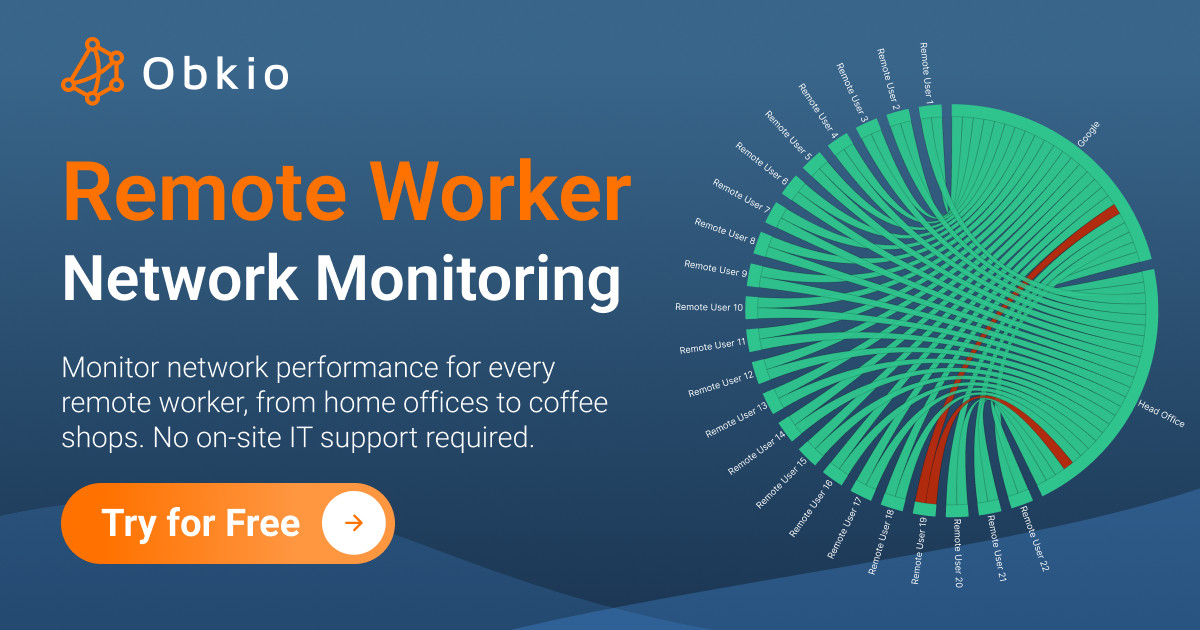













 Obkio Blog
Obkio Blog





